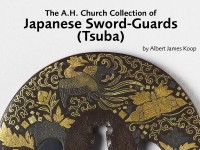The A. H. Church Collection of Japanese Sword-Guards (Tsuba)
An unpublished catalogue of the A. H. Church collection of Japanese sword-guards (tsuba) by Albert James Koop.

About the Ōnin era (1467-8), according to some authorities, the older types of guard in plain iron began to take on an enrichment of flat brass incrustation, mainly in designs of heraldic and floral motives. At any rate, the name Ōnin-tsuba is given to an early type in thin iron with slightly raised brass inlay of natural objects simply and even crudely designed and intermixed with heraldic badges.
To this were later added silver and copper and the designs became more varied and refined, with engraving finish. Such guards are unsigned until towards 1600, and then only some of the more elaborate productions bear signatures, which usually indicate the artist’s residence in Kiōto (Heianjō) or Nishijin, one of its districts, whence the term Heianjō-zōgan.
What, however, looks like the most primitive of all types of incrustation has not as yet been given any special Japanese name, and one may suggest for it the provisional label of “nail-head” incrustation. It is a coarse sort of pique work, with rows of brass nails or pins hammered into the thin iron ground, and may be accompanied by piercings which are outlined on the field of the guard by hotsuri-zōgan or encrusted brass wires.
 Tsuba with myōga, or ginger shoots (EAX.10105)
Tsuba with myōga, or ginger shoots (EAX.10105)
 Tsuba with wisteria and dewdrops (EAX.10106)
Tsuba with wisteria and dewdrops (EAX.10106)
 Tsuba with scattered plum-blossoms (EAX.10106.a)
Tsuba with scattered plum-blossoms (EAX.10106.a)
 Tsuba with willow branches, thatched shelters, and bamboo (EAX.10107)
Tsuba with willow branches, thatched shelters, and bamboo (EAX.10107)
 Tsuba with flowers and tendrils (EAX.10108)
Tsuba with flowers and tendrils (EAX.10108)
 Mokkō-shaped tsuba with pine tree (EAX.10109)
Mokkō-shaped tsuba with pine tree (EAX.10109)
 Tsuba with chrysanthemums (EAX.10110)
Tsuba with chrysanthemums (EAX.10110)
 Tsuba with bamboo and snow (EAX.10111)
Tsuba with bamboo and snow (EAX.10111)
 Mokkō-shaped tsuba with bamboo and birds (EAX.10112)
Mokkō-shaped tsuba with bamboo and birds (EAX.10112)
 Tsuba with leaves and tendrils (EAX.10113)
Tsuba with leaves and tendrils (EAX.10113)
 Mokkō-shaped tsuba with karakusa, or scrolling plant pattern (EAX.10113.a)
Mokkō-shaped tsuba with karakusa, or scrolling plant pattern (EAX.10113.a)
 Lobed tsuba with flowers and fans (EAX.10114)
Lobed tsuba with flowers and fans (EAX.10114)
 Mokkō-shaped tsuba with karakusa, scrolling floral pattern (EAX.10114.a)
Mokkō-shaped tsuba with karakusa, scrolling floral pattern (EAX.10114.a)
 Round tsuba with cherry blossoms and karakusa, or scrolling plant pattern (EAX.10115)
Round tsuba with cherry blossoms and karakusa, or scrolling plant pattern (EAX.10115)
 Round tsuba with landscape and plants (EAX.10115.a)
Round tsuba with landscape and plants (EAX.10115.a)
 Mokkō-shaped tsuba with pine tree and bamboo (EAX.10116)
Mokkō-shaped tsuba with pine tree and bamboo (EAX.10116)
 Tsuba with foliated stems and star shapes (EAX.10117)
Tsuba with foliated stems and star shapes (EAX.10117)
 Tsuba with chrysanthemum florets (EAX.10118)
Tsuba with chrysanthemum florets (EAX.10118)
 Round tsuba with wheel spokes and roped rim (EAX.10119)
Round tsuba with wheel spokes and roped rim (EAX.10119)
 Round tsuba with foliage (EAX.10120)
Round tsuba with foliage (EAX.10120)
 Tsuba with bamboo leaves and semicircles (EAX.10121)
Tsuba with bamboo leaves and semicircles (EAX.10121)
 Round tsuba with half-wheels and bamboo leaves (EAX.10122)
Round tsuba with half-wheels and bamboo leaves (EAX.10122)
 Tsuba with scrolls, dragonflies, and a stream (EAX.10123)
Tsuba with scrolls, dragonflies, and a stream (EAX.10123)
 Round tsuba with brass studs (EAX.10124)
Round tsuba with brass studs (EAX.10124)
 Tsuba with maples leaves and brass rim (EAX.10125)
Tsuba with maples leaves and brass rim (EAX.10125)
 Mokkō-shaped tsuba with rocks and bamboo-grass (EAX.10126)
Mokkō-shaped tsuba with rocks and bamboo-grass (EAX.10126)
 Round tsuba with cobweb and spider (EAX.10127)
Round tsuba with cobweb and spider (EAX.10127)
 Tsuba with squirrels and a vine (EAX.10128)
Tsuba with squirrels and a vine (EAX.10128)
 Tsuba with plants and animals (EAX.10129)
Tsuba with plants and animals (EAX.10129)
 Lenticular tsuba with flowers and dewdrops (EAX.10130)
Lenticular tsuba with flowers and dewdrops (EAX.10130)
Notice
Object information may not accurately reflect the actual contents of the original publication, since our online objects contain current information held in our collections database. Click on 'buy this publication' to purchase printed versions of our online publications, where available, or contact the Jameel Study Centre to arrange access to books on our collections that are now out of print.
© 2013 University of Oxford - Ashmolean Museum





